To celebrate the start of Crave Sydney food month, Quarter Twenty One Cookery School held an intimate chef’s table event with Chef Shin Takagi from Japan. Flying in for a two day visit, he was joined by Chef Justin North of Bécasse and Quarter 21 on a morning tour of the Sydney Fish Market and the Eveleigh markets before returning to Quarter Twenty One Cookery School in the evening to create a menu inspired by Australian seafood and produce.
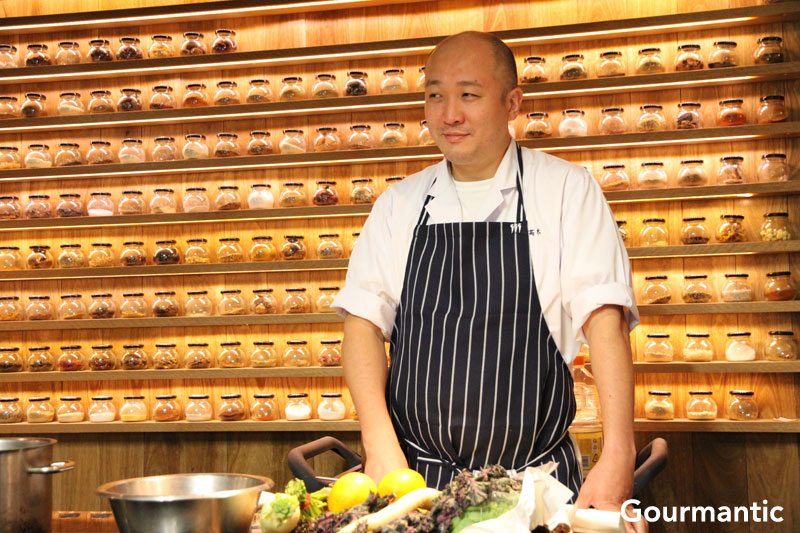
Chef Shin Takagi at Quarter Twenty One Cookery School
Shinichiro Takagi is owner and head chef at Zeniya – a kaiseki – which is a Japanese haute cuisine restaurant. Located in Kanazawa on the western coast of Japan, it is approximately 500 kilometres north of Tokyo and 200 kilometres north-east of Kyoto.
As one of Japan’s top young chefs, he continued the culinary traditions of his father after completing a degree in commercial science. In 1994, he began work as a trainee chef at Kyoto Kitcho, one of Japan’s top kaiseki restaurants that has three Michelin stars before he returned to Kanazawa in 1997 and later became Executive Chef and Owner of Zeniya.
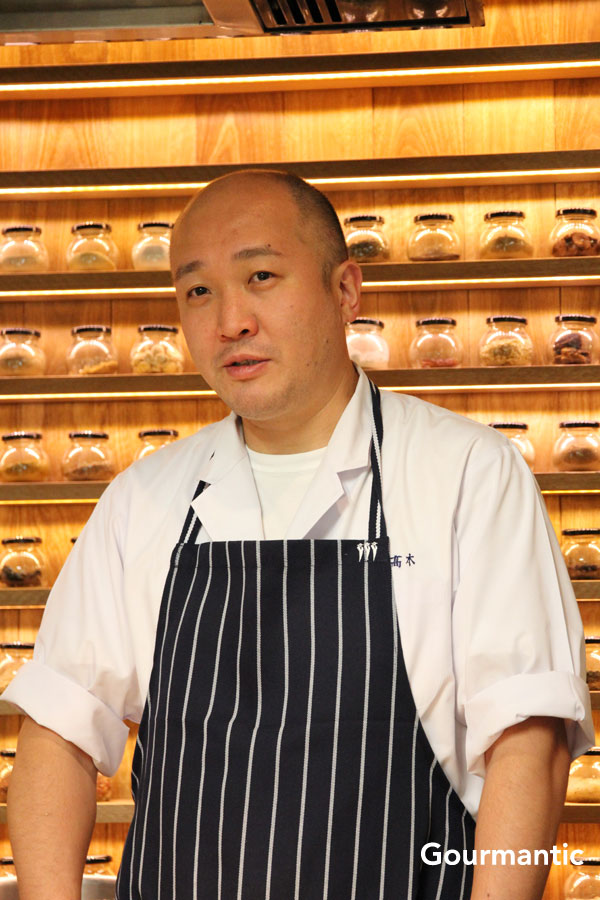
Chef Shin Takagi
His intimate restaurant seats seven people at the bar and has six private rooms, with a capacity for 50 to 60 persons. Privacy is very important to his Japanese customers and the restaurant keeps guests from seeing other guests, to the point of ensuring they don’t cross paths even on their way to the amenities. Meals at Zeniya are served in small bowls and are presented in a manner that your dining partner sitting in front of you may not see what you are eating in case they find an ingredient not to their taste.
What is intriguing about Zeniya is that it has no menu and in turn, it offers a personalised dining philosophy. The chef goes to the markets daily and chooses the menu according to what he sees. He then discusses it with his staff and talks to his guests to learn about where they’ve been and what they like to eat. He likes to know how they are feeling on the day and adapts the menu based on how he thinks they will want to eat.
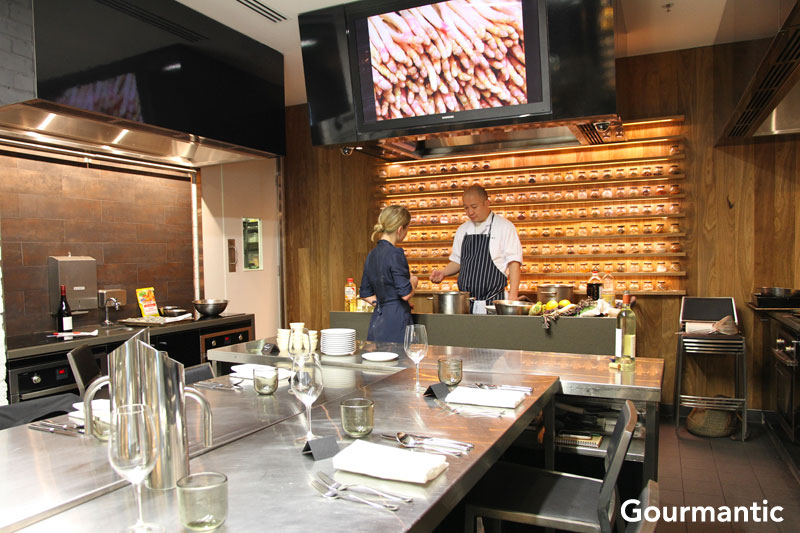
Quarter Twenty One Cookery School
At Quarter Twenty One Cookery School, a group of 12 guests are gathered for an evening with Chef Shin where he is about to take us on a culinary journey, and I am fortunate to have been invited. Libby Travers, the School’s Director ensures that much like a dinner party at home, the ambience is informal and relaxed with conversations and wine flowing amongst guests.
The Cookery School regular events and masterclasses and is located within the providore section of Quarter Twenty One, glass-enclosed on one side which enables shoppers to take a peek inside. The school is decked out with state of the art equipment, including ovens and induction cooktops by Fagor and some of the best appliances.
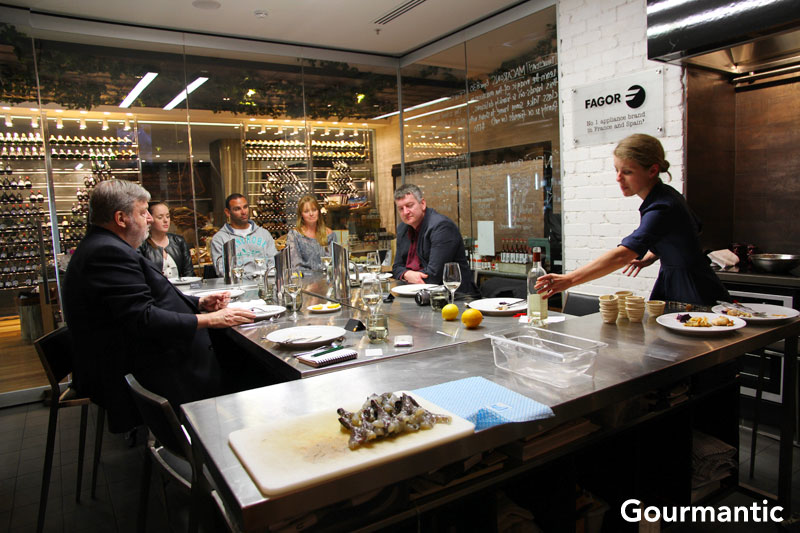
Guests, with Libby Travers (R), Director of Q21 Cooking School
As an introduction, we learn that kaiseki is based on the tea ceremony and is the most formal side of Japanese cuisine. Tea ceremonies are not performed frequently any more and they tend to last for five hours. Sushi and sashimi are not eaten in kaiseki and the dishes serve the purpose of preparing the stomach for the enjoyment of green tea. Konacha, or green tea powder, is known to be very bitter and not so good for the stomach, therefore, light dishes are prepared to ensure that guests are satiated but not too full.
The first dish tonight represents the kind of food Chef Shin has been eating since he was young and a personal favourite of his. Using fresh oysters bought from Christie’s at the Sydney Fish Markets during the morning tour, he prepares deep fried oysters.
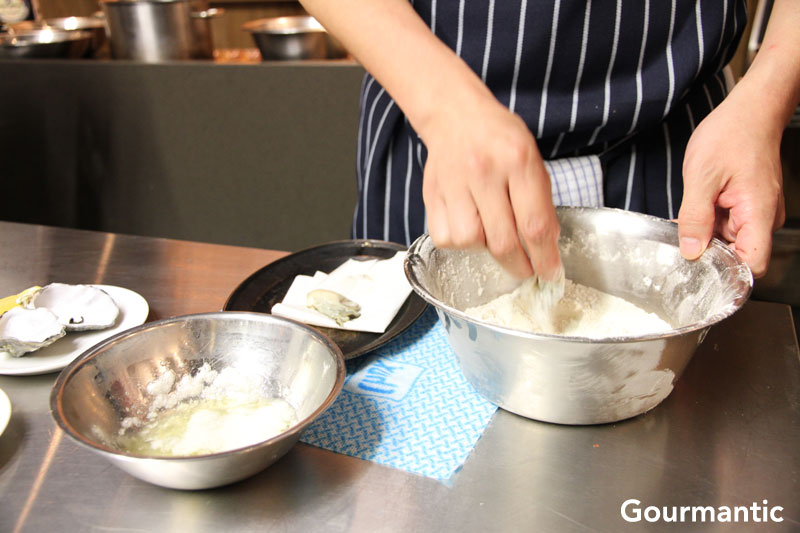
Preparing oysters
He explains that when foreign people think of deep frying in Japanese cuisine, they think of tempura. The technique may have come China or possibly Poland before it was popularised in the United States after World War II, but people in Japan now adopt it as their own they use it in many ingredients such as pork, chicken and vegetables.

Explaining deep frying and tempura
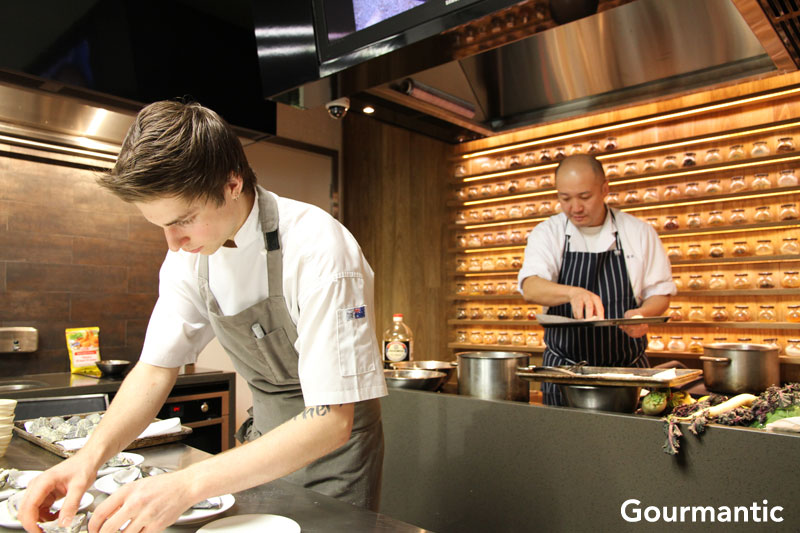
Plating by “Bieber”, Jack Bathurst, Garnish Chef at Q21
Using flour, eggs and Panko crumbs, which are slightly more elongated and give a better crunch, he coats each oyster with the mixture and deep fries until golden in colour.
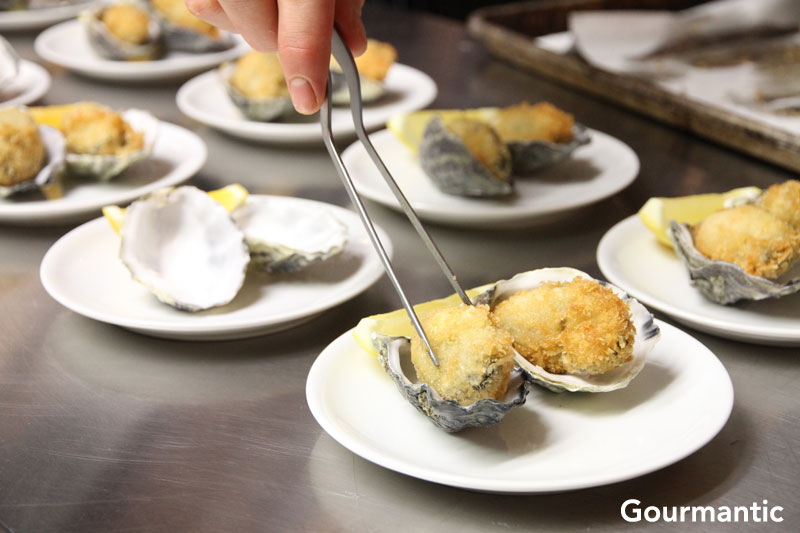
Oyster plating
The oysters are light and fresh, and taste of the sea. We taste each oyster with a Meyer lemon and compare it with an ordinary lemon, the former having a more subtle citrus flavour with less tartness.
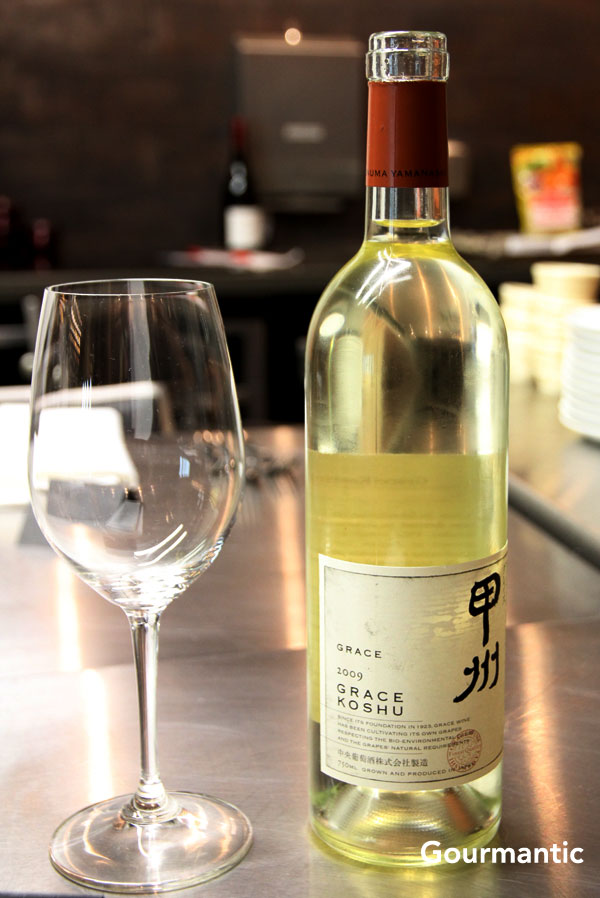
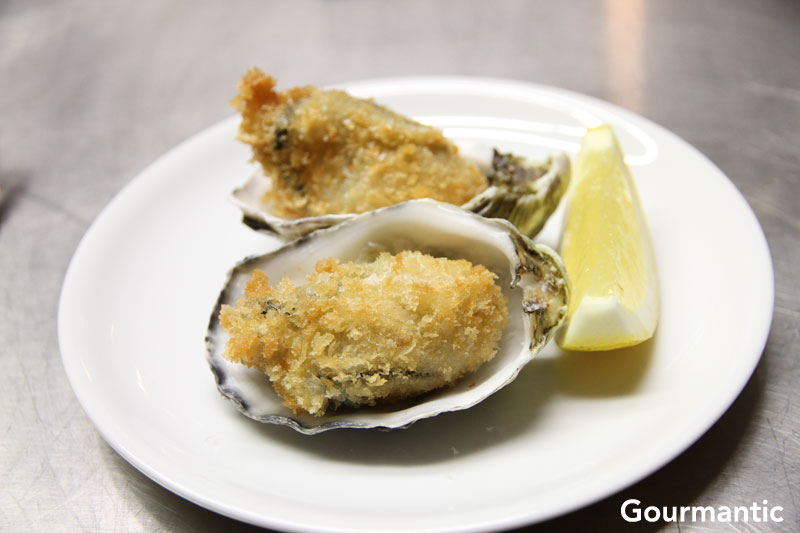
Grace Koshu wine and Oysters
The wine we are drinking tonight is the 2009 Grace Koshu from the Yamanashi prefecture in Japan, a range of wines that I have had the privilege of tasting last year at a masterclass with winemaker Ayana Misawa of Grace Wines at the Ultimo Wine Centre in Sydney. Grace Koshu is made using the indigenous Koshu grape in Japan. Pale yellow in colour, it has a delicate taste with a hint of citrus and floral notes on the finish.
Oishii. Delicious.
The second dish Chef Shin prepares makes use of the produce bought from the market tour in the morning. Chicken breasts are cut into pieces then marinated in a mixture of sake, dark soy, mirin and ginger.
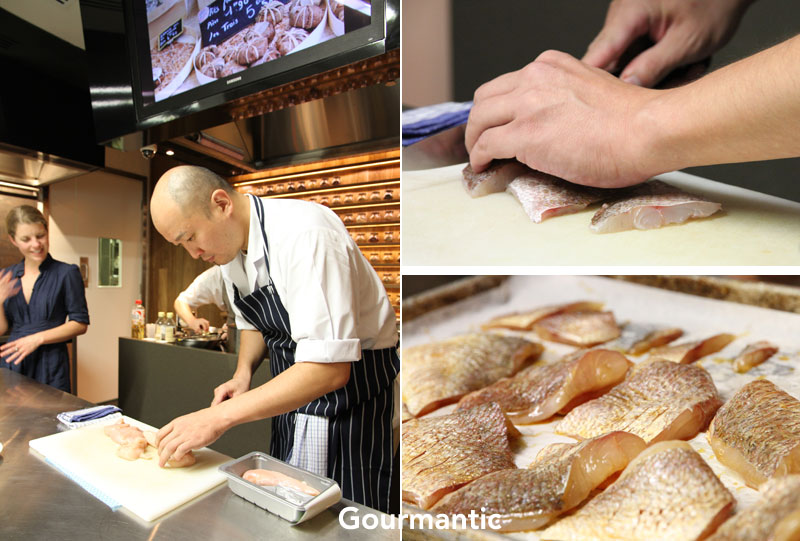
Preparing the fish
In Japanese culture, sea bream, Tai, is known as the fish of celebration and is often prepared when a baby is born. He scores the skin of the sea bream and marinates it in a mixture of sake, dark soy and mirin for twenty minutes, in the ratio of 5:3:2. He explains that in his cuisine, he uses dark soy primarily for taste, and light soy, which is saltier, to impart flavour.
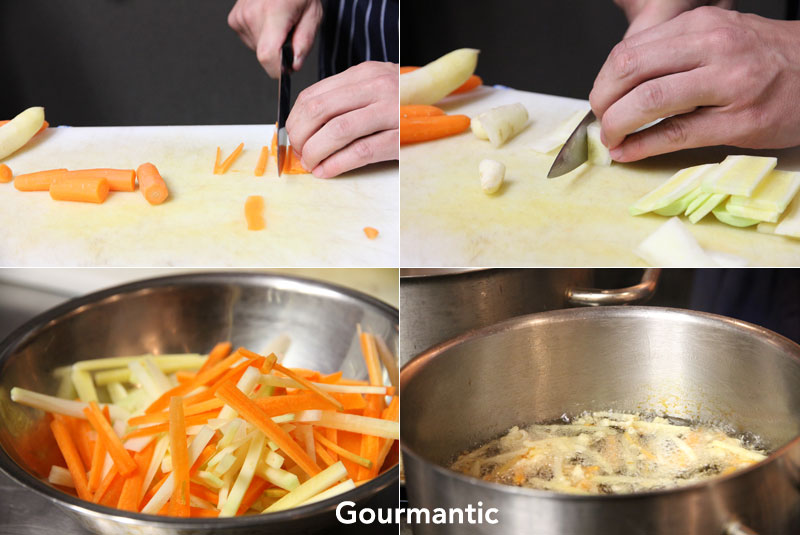
He slices orange carrots and white carrots which are an heirloom variety into thin matchsticks in preparation for tempura, or a “kind of tempura” as he calls it. He only uses flour and cold water for the batter, without any egg yolk, which gives it a lighter texture and cleaner flavour.
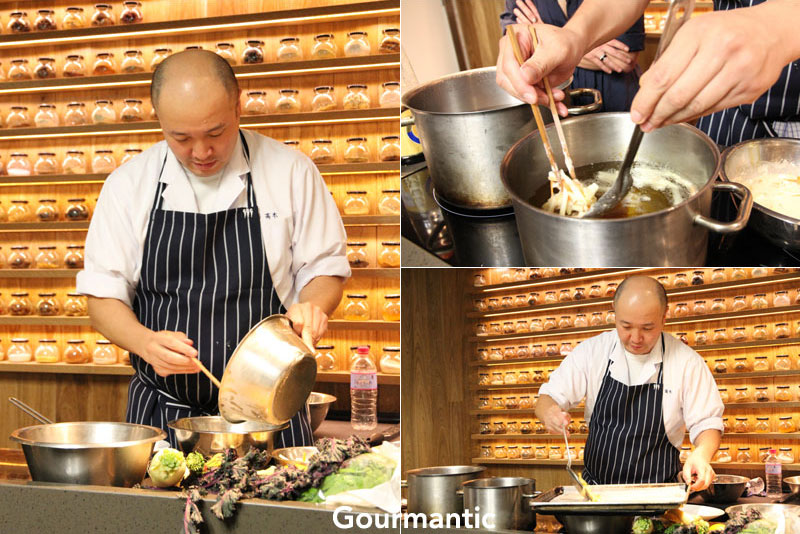 Tempura
Tempura
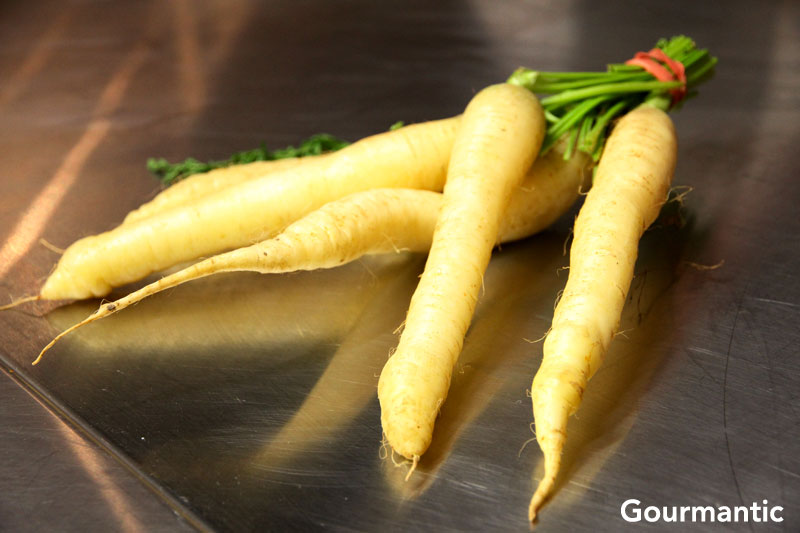
White carrots, an heirloom variety, from the Eveleigh Markets
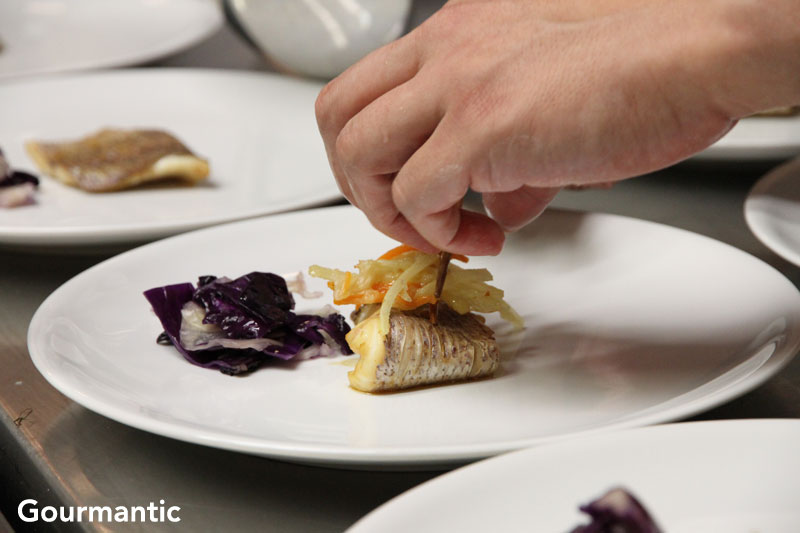
Plating the tempura vegetables over the fish
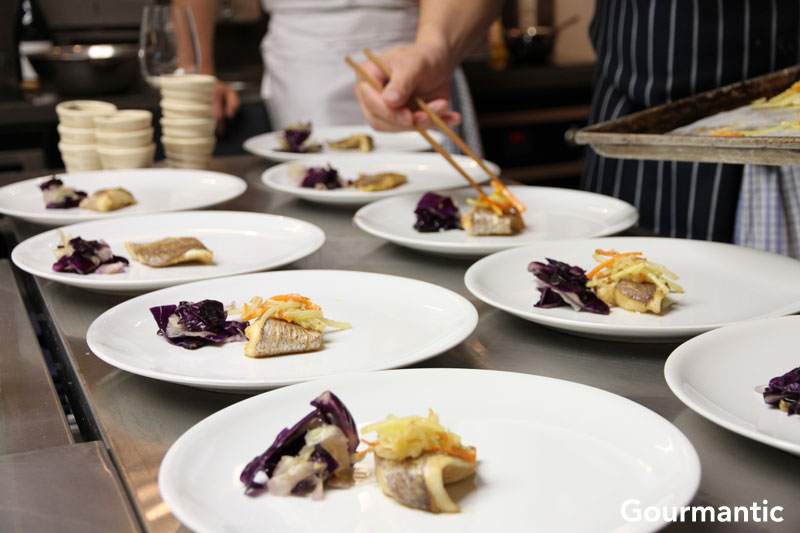
Plating in progress
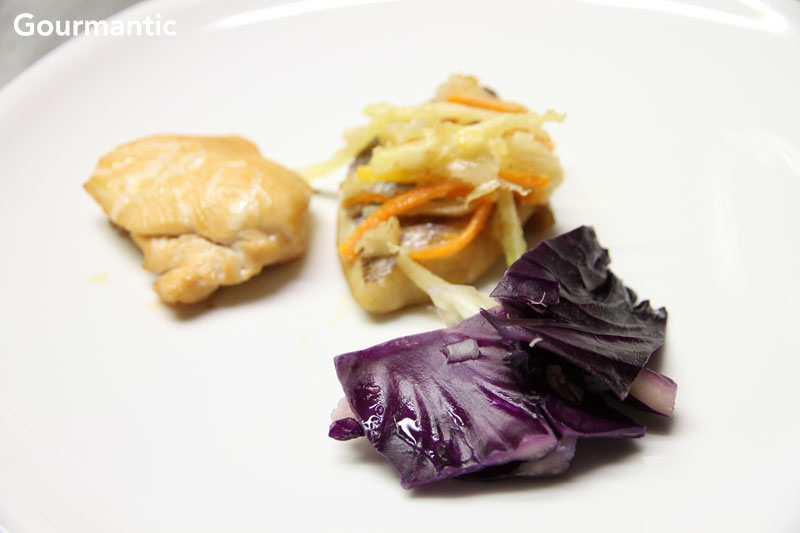
The components of the dish are plated with chicken pieces, sea bream topped with the tempura carrots, cabbage in light soy and broad bean tempura (not shown) making up a mosaic of flavour and colour.
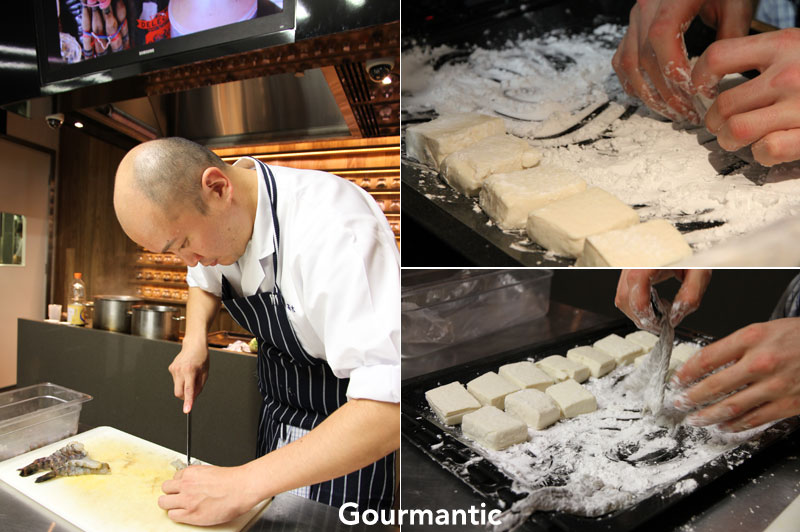
The third and last dish in kaiseki consists of a soup. Chef Shin explains that European people think it odd for soup to be served last, but it is one of the most important dishes in kaiseki cuisine, and it is not merely a broth.
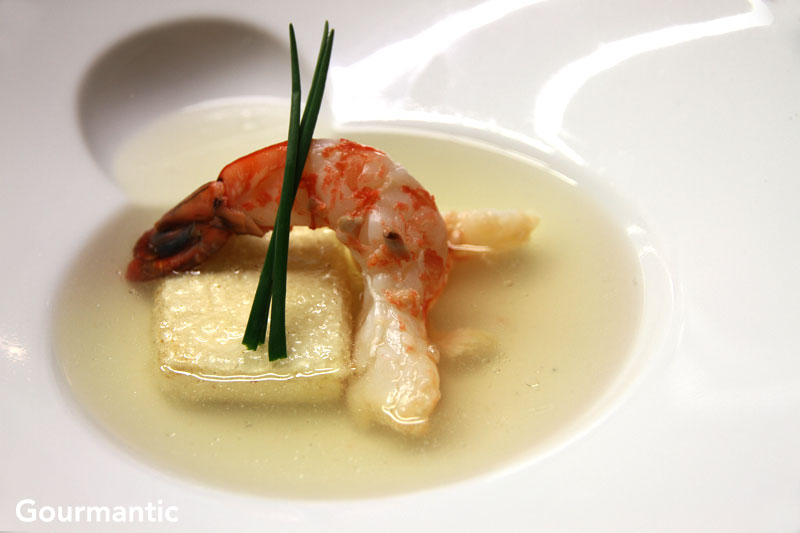
Soup dish with prawns and tofu
The soup with prawn and tofu is an elegant dish, fresh, fragrant and delicate in flavour. Chef Shin explains that red and white food is prominent in Japanese cuisine as it depicts the country’s flag and the Japanese people love it.
He also explains that he wanted to make a different type of soup base using dashi from katso bonito and seaweed konbu, but could not find the right ingredients so he made the broth from seafood and fish. Since sea bream does not have a lot of fat and some oil is good with this kind of dish, he opted for deep fried tofu to give it more flavour.

David Jouy, General Manager
David Jouy, Bécasse General Manager, joins us and speaks briefly about Grace Wines we have been enjoying before introducing the Sake as an accompaniment to the soup dish.

Tengumai sake
Tengumai Sake is a Junmai sake, a pure rice wine made using the Yamahai-jikomi method in Japan. Until recently, at least 30% of the rice used for Junmai sake had to be milled away but conventions have been relaxed. It has a golden colour, and is light, fresh and dry on the palate. While it is often difficult to match two liquids, its richer texture and fuller body go well with a consommé and the soup dish.
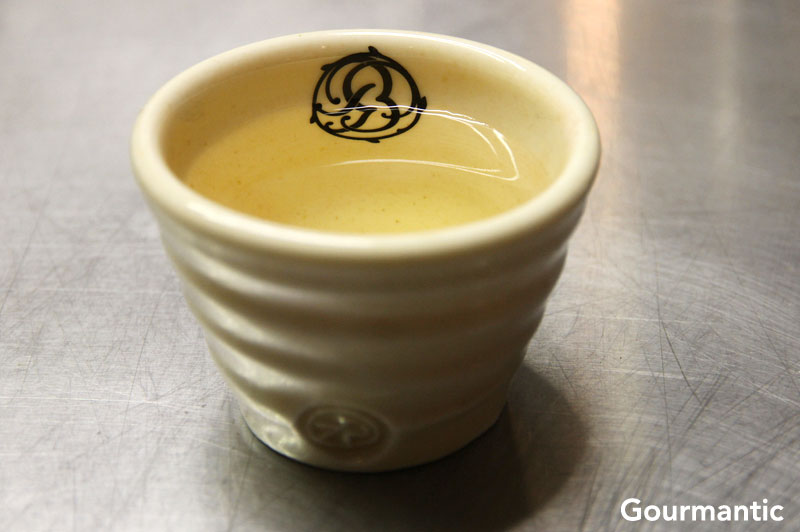
Sake served in Bécasse cup
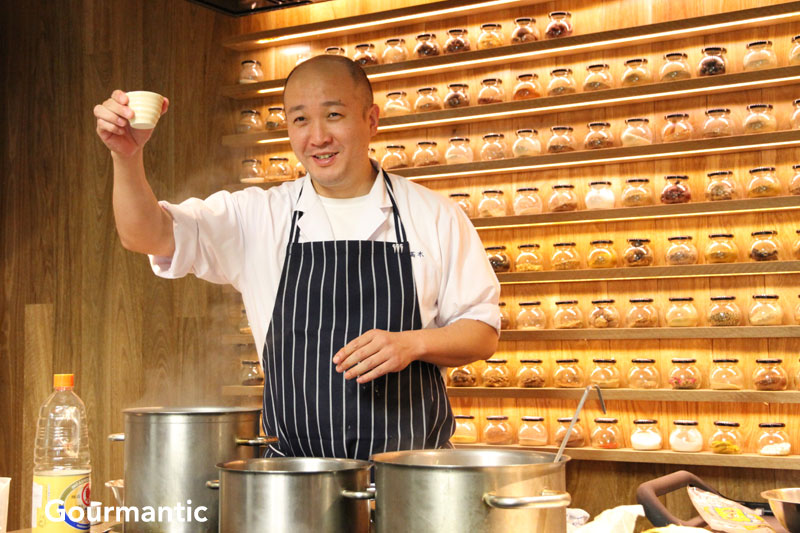
Kampai
The sake on taste turns out to be well known to Chef Shin who joins us in a toast. Not only does it come from his region, one of his schoolmate now runs the company.
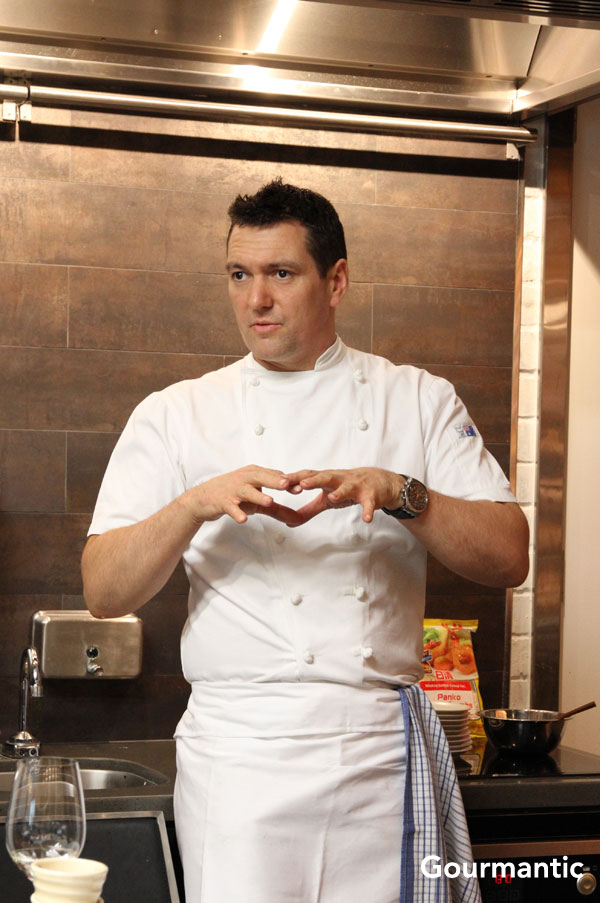
Chef Justin North
We are joined by Chef Justin North for an informal chat and he later explains a change in philosophy of the menu at Bécasse. Where the intimate restaurant previously had 5 and 9 course dégustation menus as a snapshot of their a la carte dishes, Bécasse is now purely a 7 course dégustation that takes diners on a journey of flavours and textures with a vegetarian option.
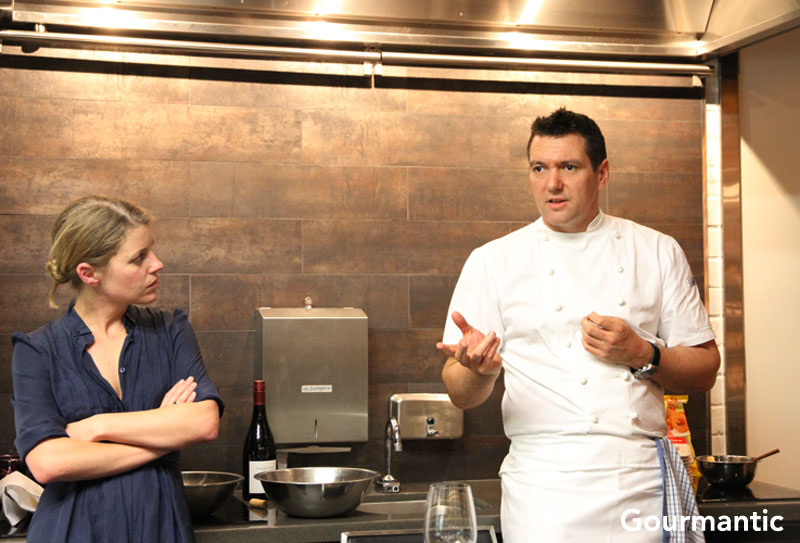
Libby Travers and Justin North
The dishes are also undergoing a change. Originally, they drew inspiration from different regions of France and while French techniques are still used, the flavours now have more influences from local regions such as Asia and Japan. His menu draws on presenting more purity and maximum flavour out of the ingredients which is difficult to achieve with rich sauces in classical French cuisine.
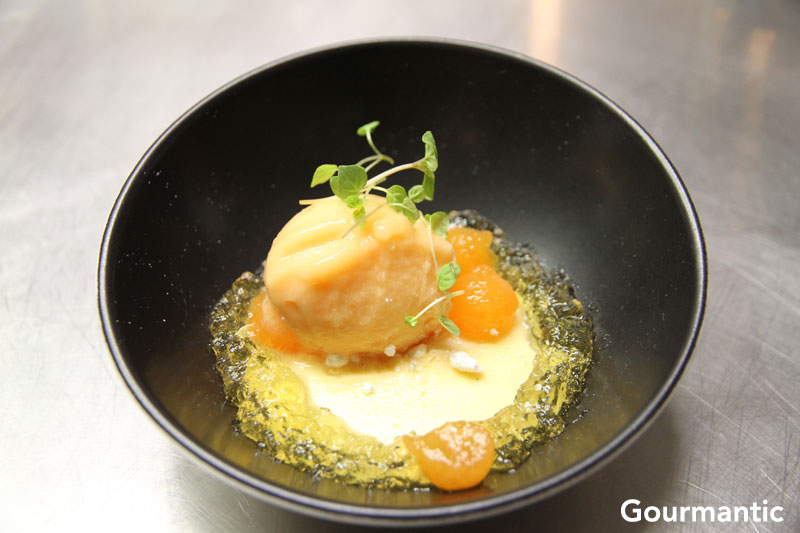
We end the meal with a fromage frais mousseline with, sweet lime jelly, compressed rockmelon, and sorbet, a light an refreshing dessert that adds a sweet flavour to a fine evening.
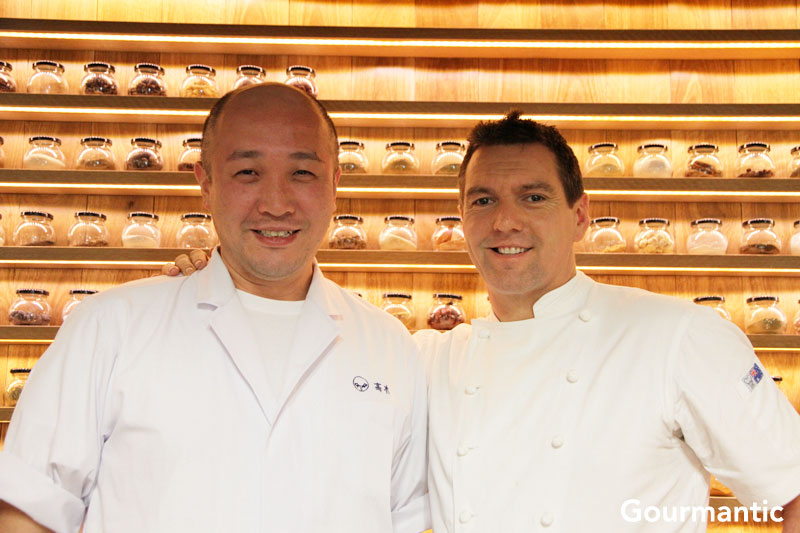
Chefs Shin Takagi and Justin North at Quarter 21 Cookery School
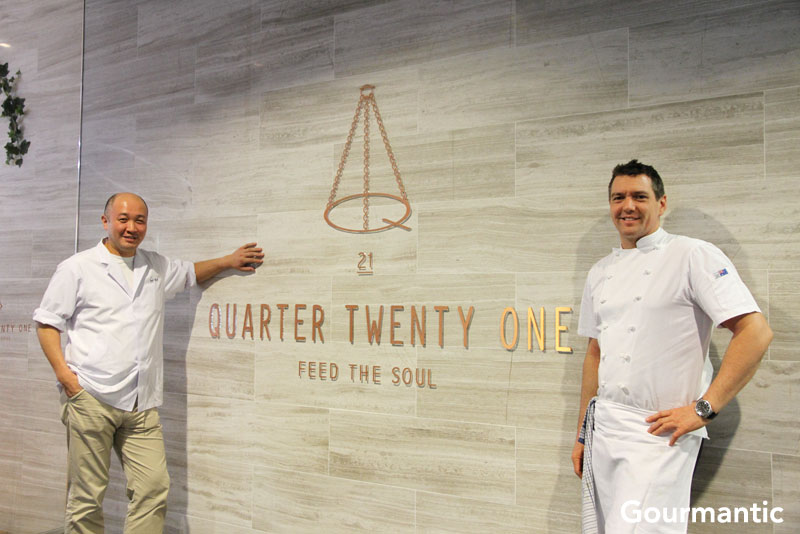
Chefs Shin Takagi and Justin North – feeding the soul
The Chef’s Table event with Shin Takagi was a delightful and educational evening of food, travel, culture and conversations. Chef Shin took me back to the time we visited Japan and became enamoured with its culture and people. The food preparation was interspersed with fascinating insights and he was very gracious in answering candid questions from our group. At the conclusion of the evening, I had the opportunity to ask him a few questions and are now featured in a Q&A style interview with Shin Takagi.
The Chef’s Table event with Shin Takagi was held on Saturday October 1st 2011 at the Quarter Twenty One Cookery School.
Gourmantic attended the event as a media guest of Drysdale Communications. With special thanks to Shin Takagi, Justin North and Libby Travers.
Zeniya
http://www.zeniya.ne.jp
Quarter Twenty One Cookery School
http://www.quartertwentyone.com.au
Bécasse
http://www.becasse.com.au




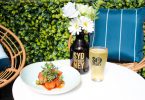

Sounds like you had an incredible experience. I like the philosophy behind his restaurant, his customers must leave there feeling very special.
Look forward to finding out more in your interview.
That’s what I thought as well. It would be a personal experience that they wouldn’t forget.
Please check out the interview. So many fascinating insights!
[…] October 1st, I had the privilege of attending an intimate chef’s table event with Shin Takagi at Quarter Twenty One Cookery School. Shinichiro Takagi is one of Japan’s top young chefs and […]
[…] team from Quarter 21 with […]
WOW! Wonderful experience!! The food and plating look so elegant. I bet the food tastes wonderful!!! And oh, those oysters…!
Everything was perfect, and although I’m not a fan of cooked oysters, these were divine!
[…] Twenty One set up a replica of their Westfield premises with a version of the Quarter Twenty One Cookery School while the front of the store had delicious honeycomb on taste from Maya Sunny Honey […]
[…] North teamed up with Quarter Twenty One Head Chef Michael Robinson and Bécasse Head Chef Monty Koludrovic to create a seasonal menu using […]